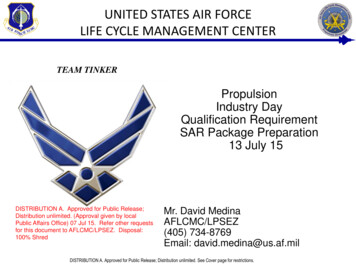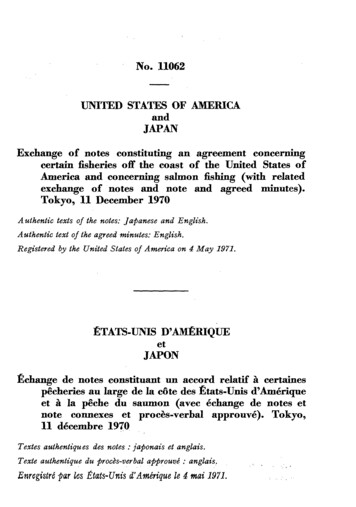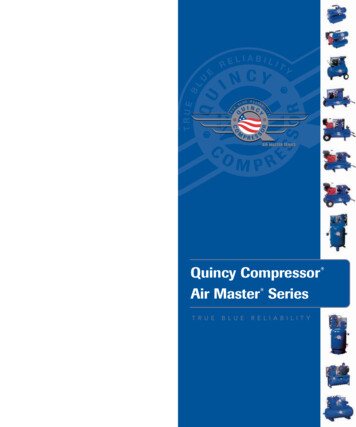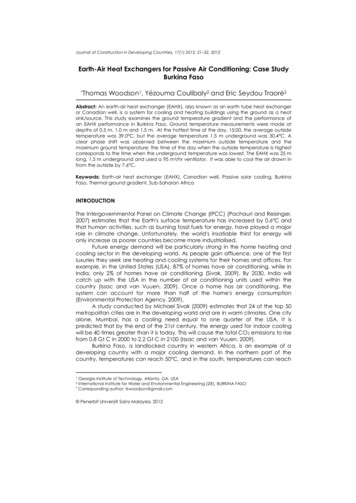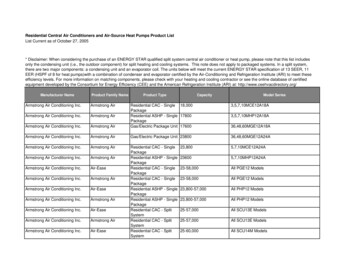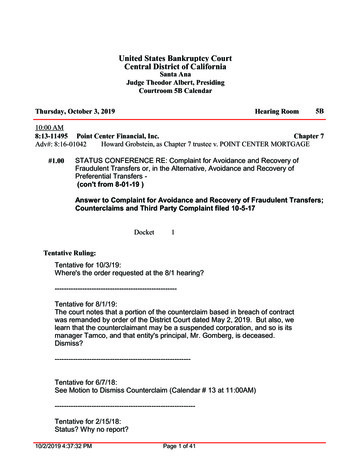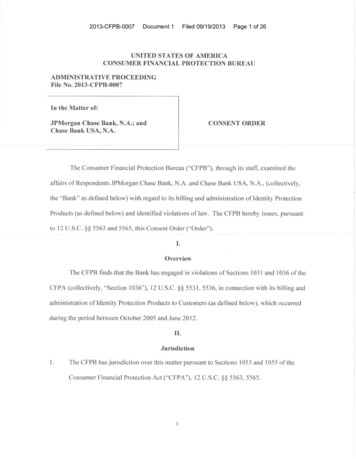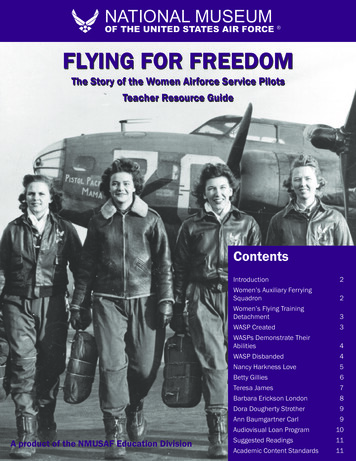
Transcription
NATIONAL MUSEUMOF THE UNITED STATES AIR FORCE FLYING FOR FREEDOMThe Story of the Women Airforce Service PilotsTeacher Resource GuideContentsIntroductionWomen’s Auxiliary FerryingSquadronWomen’s Flying TrainingDetachmentWASP CreatedWASPs Demonstrate TheirAbilitiesWASP DisbandedNancy Harkness LoveBetty GilliesTeresa JamesBarbara Erickson LondonDora Dougherty StrotherAnn Baumgartner CarlA product of the NMUSAF Education DivisionAudiovisual Loan ProgramSuggested ReadingsAcademic Content Standards223344567899101111
WASPS: BREAKING GROUND FOR TODAY’S FEMALE USAF PILOTSAn IntroductionAs early as 1930, the War Department had considered using women pilots but the Chief of the AirCorps had called the idea “utterly unfeasible,” statingthat women were too “high strung.”Famed woman aviator Jacqueline Cochran in 1939wrote Eleanor Roosevelt (wife of then-PresidentFranklin Roosevelt) to suggest women pilots could beused in a national emergency. Aviatrix Nancy Harkness Love in 1940 made a similar proposal to the AirCorps’ Ferry Command. Nothing was done until afterAmerican entry into World War II. Facing the needfor male combat pilots, the situation by mid-1943favored the use of experienced women pilots to flyArmy Air Forces aircraft within the United States.Two women’s aviator units were formed to easethis need and more than 1,000 women participatedin these programs as civilians attached to the AAF.These were merged into a single group, the WomenAirforce Service Pilots (WASP) program in August1943 and broke ground for USAF female pilots whowould follow in their footsteps.Jacqueline CochranWomen’s Auxiliary Ferrying SquadronThe Women’s Auxiliary Ferrying Squadron, nevernumbering more than 28, was created in September1942 within the Air Transport Command, under Nancy Harkness Love’s leadership. WAFS were recruitedfrom among commercially licensed women pilotswith at least 500 hours flying time and a 200-hp rat-ing. (Women who joined the WAFS actually averagedabout 1,100 hours of flying experience.) Their original mission was to ferry Army Air Force trainers andlight aircraft from the factories, but later they weredelivering fighters, bombers and transports as well.Cornelia FortA WASP gets her wings.2 Visit www.nationalmuseum.af.mil for lesson plans and more
Women’s Flying Training DetachmentMeanwhile, a training program for women pilots,under Jacqueline Cochran was approved on Sept. 15,1942, as the Women’s Flying Training Detachment(WFTD). The 23-week training program, begun inHouston, Texas, included 115 hours of flying time.Training soon moved to Avenger Field at Sweetwater,Texas, and increased to 30 weeks with 210 hours offlying.Trainees were between 21 (later dropped to 18)and 35 years old, and already had at least 200 hourspilot experience (later reduced to 35 hours), but weretaught to fly military aircraft the Army Air Force way.Their training emphasized cross country flying withless emphasis on acrobatics and with no gunnery orclose formation flight training.WASP trainingWASP CreatedIn August 1943, all women pilots flying for theArmy Air Force were consolidated into the WomenAirforce Service Pilots (WASP) program with Jacqueline Cochran as AAF Director for Women Pilots.Nancy Harkness Love was named the WASP executive on the Air Transport Command Ferrying Division staff. More than 25,000 women applied for pilottraining under the WASP program. Of these, 1,830were accepted, 1,074 graduated and 900 remained atprogram’s end, plus 16 former WAFS. WASP assignments after graduation were diverse — as flight training instructors, glider tow pilots, towing targets forair-to-air and anti-aircraft gunnery practice, engineering test flying, ferrying aircraft and other duties.Three WASPs on right wing of A-25 checking theflight plan before a tow mission.Register online for upcoming educational programs 3
WASPs Demonstrate Their AbilitiesWASP pilots in front of USAAFB-17 “Pistol Packin Mama”Women pilots sometimes encountered resentmentfrom males. For example, the only WASP in a P-47class of 36 males was considered an intruder — untilshe became the fourth in the group to solo in the hugefighter. WASPs later routinely ferried P-47s from thefactory.WASPs made demonstration flights in the “hot”B-26 Marauder and the new B-29 Superfortress,challenging male egos and showing that these aircraftweren’t as difficult to fly as some men felt them to be.Ann Baumgartner became the first woman to fly anUSAAF jet when she flew the Bell YP-59A twin jetfighter at Wright Field. WASPs flew virtually everytype of aircraft from light trainers to heavy fourengine bombers. They flew about 60 million milesor 2,500 times around the world at the Equator, with38 deaths. Before and after graduation, their accidentrate was comparable to that for male pilots doingsimilar jobs.WASP DisbandedWASPs had the privileges of officers, but theywere never formally adopted into the U.S. Army AirForce even though they were led to believe this wouldhappen. They remainedcivil service employeeswithout injury or deathbenefits. In 1944 bills inCongress to militarizethe WASPs met withstrong opposition fromsome individuals, including famed columnistDrew Pearson and failedlike other attempts.Due to political pressures and the increasedavailability of malepilots, the WASPs weredisbanded effective onDec. 20, 1944, with no benefits. The exploits of thesededicated women were largely ignored by the U.S.government for more than 30 years. In November1977, however, President Carter signed a bill grantingWorld War II veterans’ status to former WASPs.The WASP pilots were an important element in themovement of women into war work to free men forcombat and other duties.Gen. Henry H. Arnold,speaking before the lastWASP graduating classat Sweetwater, Texason Dec. 7, 1944, paidtribute to them in thismanner.“You have shownthat you can fly wingtipto wingtip with yourbrothers. If ever therewas a doubt in anyone’smind that women couldbecome skilled pilots,the WASPs dispelledthat doubt. I want to stress how valuable I believe thewhole WASP program has been for the country.”4 Visit www.nationalmuseum.af.mil for lesson plans and more
Nancy Harkness LoveNancy Harkness Love was 28 years old when shebecame the leader of the WAFS. She learned to flysome 12 years before at her birthplace, Houghton,Mich. She took flying lessons and received a privatepilot license at age 16 while she was a student atMilton Academy, Milton, Mass. She entered VassarCollege and continued to spend her summer vacationsflying. At this time she pioneered in the developmentof student flying clubs in American colleges. Lovereceived her commercial pilot license in 1933, andin 1935 she was engaged by the Bureau of Air Commerce as one of a group of three women fliers to airmark the principal cities of the United States.In January 1936 she married Robert M. Love;thereafter, she helped him in their company, InterCity Aviation, at the Boston Airport, gaining experience in ferrying by delivering planes to customers. In1937 she tested and demonstrated Gwinn Aircar andHammond “safety planes” and demonstrated tricyclelanding gear on safety planes for the Bureau of AirCommerce. While working on the operations staff atBaltimore before the organization of the WAFS, Lovehad become thoroughly experienced in mapping ferryflights, and had become familiar with ferry routes,military operations, etc. At the opening of September1942, Love had logged over 1,200 flight hours, andheld a CAA instrument rating, a CAA commerciallicense, a sea plane rating and was qualified to flyplanes of 600 hp.Through the end of 1942, the WAFS ferried primary trainers and liaison aircraft only. Love and someof the more advanced WAFS were dissatisfied withbeing restricted to ferrying these elementary types ofaircraft. Since they were the only types being flownby the original group at New Castle Field, Wilmington, Del., Love preferred to go with a cadre of WAFSto Dallas where a new WAFS unit was formed. BettyGillies was placed in command of the group at Wilmington. At Dallas it was possible for the women toprogress to flying basic and advanced trainer types.During January 1943, Love ferried an AT-6.With the establishment of a WAFS cadre in the 6thFerrying Group at Long Beach, Calif., it was possibleto take transition on more advanced aircraft. The 6thwas the oldest and most important Ferrying Groupin the Air Transport Command, handling an exceptionally wide variety of aircraft. Without publicity,as official directivesstill restricted WAFSto light aircraft, Lovechecked out in a NorthAmerican P-51 Mustang on Feb. 27.On March 3 Loverequested a permanentchange of station fromDallas to Long Beach.The transfer was approved on March 11.On March 5, 1943,she ferried a DouglasLoveC-47 from Long Beachto Memphis, Tennessee, with Barbara Erickson ascopilot. This represented an important step forward tothe flying of a relatively heavy, twin-engine aircraftover a considerable distance. By then she was qualified on C-47s, A-36s, P-51s, and some 14 other typesof aircraft, most of which were manufactured in theLong Beach area.Later in the spring of 1943, with the expansion inWAFS activities deriving from the arrival of the firstgraduates of the Women’s Flying Training Detachment school, it was decided to transfer Love to Ferrying Division Headquarters. In order to gain more experience in flying medium and heavy types of planes,Love postponed the move until June, and then, on theway to Cincinnati, she ferried a North American B-25Mitchell from Long Beach to Kansas City.In August 1943, Love and Gillies, who might becalled the deans of women pilots in the Army AirForces, checked out on B-17s. In the following monthan attempt was made to have them deliver a B-17 tothe United Kingdom. Some question has been raisedas to the propriety of this move. In fact, there appearsto have been no impropriety. The only documentrestricting women pilots to domestic ferrying, emanating from a higher source than the Ferrying Division itself, is Gen. George’s memorandum to GeneralArnold which provided a basis for the establishmentof the original WAFS.Love and Gillies departed Cincinnati on Sept. 2,1943, piloting B-17F serial number 42-30624, and(continued on next page)Register online for upcoming educational programs 5
(Love continued)arrived that evening at Presque Isle, Maine. Gen.Tunner had personally instructed them to fly viaGoose Bay, Labrador, a route which would give themrelatively short hops to Greenland, Iceland, and thenPrestwick, Scotland, instead of going by the moreusual route via Gander, Newfoundland, nonstop toPrestwick. They arrived at Goose Bay on Sept. 4,encountering instrument weather on the way. Theywere delayed there by weather. On that day, Gen. C.R.Smith wired Brig. Gen. Paul E. Burrows, commanding the European Wing, advising him of the flightand instructing him to notify Gen. Arnold, who wasthen in London. This Gen. Burrows did on Sept. 5and Gen. Arnold’s reaction was most unfavorable. Hedispatched a wire to Gen. Giles ordering the trip becanceled and that “no women fly transoceanic planesuntil I have time to study and approve.” The messagewas relayed to Goose Bay, arriving just 15 minutesbefore the women were ready to take off. Had theygone via Gander, they would by that time have beencoming into Prestwick.When the WAFS and WFTD were merged intothe WASP, Love was named Executive in charge ofall WASP ferrying operations. After the war, she wasawarded the Air Medal for her service in support ofaircraft ferrying operations.Betty GilliesThe first pilot toqualify for the WAFSwas Betty HuylerGillies of Syosset,Long Island, N.Y. Sheentered the WAFS onSept. 12, 1942. Gillies at this time had 14years of flying experience, running up atotal of 1400 hours toher credit, held variousaeronautical ratings,Gilliesand for two years(1939-1941) was president of the Ninety-Nine’s, aninternational club of women flyers formed in 1929.When Nancy Love transferred to Love Field, Dallas, Texas, to start a new WAFS ferrying unit, Gillieswas made squadron leader of the WAFS assigned tothe 2nd Ferrying Group, New Castle Army Air Base,Wilmington, Del.In early March 1943 Gillies became the first woman to fly the Republic P-47 Thunderbolt when she waschecked out on the aircraft at Wilmington. The “checkout” consisted of an explanation (on the ground) ofaircraft systems, flight characteristics and emergencyprocedures. Since the P-47 was a single seat aircraft,her first flight was also her first solo flight.One of the outstanding ferry missions accomplished by the original Squadron at Wilmington camein April 1943, when four PT-26s were delivered fromHagerstown, Md., to DeWinton, Alberta, Canada, adistance of more than 2,500 miles. Gillies was flightleader, and the other three pilots were Nancy Batson,Helen McGilvery and Kathryn Bernheim. The typeof plane flown had a cruising speed of only around100 mph. They left Hagerstown on April 18, spentthe night at Joliet, Ill. (697 miles away), spent thenext night at North Platte, Neb., after a run of 585miles, then made a long hop of 846 miles to GreatFalls, Mont. On April 21 they flew the remaining 275miles to DeWinton, Alberta. All four pilots were backat the 2nd Group by Friday evening, April 23, andwere commended by Col. Baker for their efficient andprompt delivery, which included not only the flyingof the planes but also the paperwork involved in suchdeliveries, such as flight logs, gasoline reports andRON (remain over night) messages.On Aug. 15, 1943, Love and Gillies qualified asfirst pilots (i.e. aircraft commanders) on Boeing B-17sand made three deliveries together during the balance of the month. On Sept. 2, 1943, Gillies and Lovedeparted Cincinnati on a ferry mission to deliver aB-17F to England; however, the mission was canceledbefore the aircraft left Goose Bay, Labrador.Gillies remained squadron leader of the WASPs assigned to the 2nd Ferrying Group at New Castle ArmyAir Base until the WASPs were disbanded on Dec. 20,1944.6 Visit www.nationalmuseum.af.mil for lesson plans and more
Teresa JamesTeresa James began taking flying lessons in September 1933 and earned her private pilot’s license inOctober 1934. Soon after, she was performing in airshows as a stunt pilot; her signature “stunt” was a 26turn spin.In the summer of 1940, James earned her instructorpilot license followed by a commercial pilot license inOctober 1941. She also became a volunteer pilot forthe Civil Air Patrol, helped organize a new unit andcontinued teaching student pilots.In the summer of 1942, James was a Civilian PilotTraining Program instructor in commercial aviation atPittsburgh, Penn., and had 10 years flying experienceand more than 2,000 flying hours.James arrived at New Castle Army Air Base,Wilmington, Dela., on Sunday, Sept. 20, 1942, andtook her flight check the next day flying a Taylorcraft L-2B. She was accepted and became the eighthWAFS pilot to qualify.James flew in the first WAFS ferry mission on Oct.22, 1942. A group of six WAFS (Rhonie, Fort, Clark,Scharr, James and Gillies as Flight Leader) took offfrom the Piper aircraft factory in Lockhaven, Penn.,and delivered L-4Bs to Mitchell Field, Long Island,N.Y., on Oct. 23 after an overnight stay in Allentown,Penn.Her first chance as flight leader came on Dec. 12,1942. A group of six WAFS (Batson, Bohn, Burchfield, Miller, Thompson and James as flight leader)took off from Calgary, Alberta, Canada, in StearmanPT-17 open cockpit trainers and delivered them toGreat Falls, Mont.Perhaps the most unique mission James flew wasto ferry a Fairchild PT-19 to California for use ina movie. On Feb. 17, 1943, she picked up the newplane from the Fairchild factory in Hagerstown,Maryland, and delivered it to the famous aviator PaulMantz in Hollywood for use in “Ladies Courageous,”a not very accurate movie loosely based on the WAFSprogram. After delivering the plane on Feb. 22, shebecame somewhat of a celebrity — she had dinnerwith Bob Hope and met quite a few movie stars.During the summer of 1943, James checked out inpursuit aircraft. The Republic factory making P-47swas in Farmingdale, N.Y., and the WASPs assignedto New Castle Army Air Base were often assigned toferry new Thunderbolts from the factory to the em-Jamesbarkation port in New Jersey for transport via ship toEurope.One memorable trip began in the summer of 1944with what was supposed to be a short ferry missionfrom the Republic plant to a modification center inIndiana. After delivering the P-47, instead of returning to New Castle Army Air Base, James was sentfurther west and delivered another P-47 from Indiana to California. After a brief checkout in the P-51Mustang, she ferried one from California to Florida.Next, she flew a North American AT-6 from Florida toWashington State. She delivered two more aircraft onthe way back to Delaware — a Bell P-39 from Oklahoma to Montana and another P-47 from Montanaback to New Castle, Dela. Her scheduled one-day triplasted four weeks!On Sept. 20, 1944, James was selected to fly the10,000th P-47 built from the Republic factory to theoverseas embarkation port in Newark, New Jersey.By the time the WASP program was disbanded,James was checked out in about 20 different typesof military aircraft, including the A-24, AT-6, AT-10,C-47, C-60, P-47 and P-51.In 1950 James was commissioned a major in theUSAF Reserves. She served until her retirement in1976. Although she was not able to fly as an Air Forcepilot, she served in various troop carrier units and wasable to get some unofficial flight time as a copilot inthe C-54, C-119 and C-130.Register online for upcoming educational programs 7
Barbara Erickson LondonBarbara Jane “BJ” Erickof aircraft involved and theson, of Seattle, Wash., was amileage as given, she may besophomore at the University ofestimated to have piled up atWashington when she signedleast 40 hours — as much asup for the Civilian Pilot Trainone of the 2nd Ferrying Grouping course. Immediately uponWASPs could have hopedgraduation she was made anfor in a full month. For theseinstructor and flew seaplanesflights, Erickson was awardedas well as landplanes. Uponthe Air Medal, the only onereceiving her telegram invitawarded to a WASP duringing her to join the Women’sWorld War II. (Note: MoreAuxiliary Ferrying Squadron,medals were awarded after theshe broke off in the middle ofwar.)a class she was teaching andDuring the first two weeksleft for New Castle Army Airof August 1944, the experiField, Wilmington, Dela. Shement was made of stationingwas accepted into the programtwo of the most experiencedand became the 14th womanWASPs, Erickson and Floreneto qualify.Miller, at the 3rd FerryingErickson transferred fromGroup, Romulus, Mich., to flyNew Castle to Long Beachon the domestic Military AirArmy Air Base, Calif., andTransport Service from thereGen. Hap Arnold and Barbara Ericksonbecame the commanding ofto Chicago, Illinois. They hadat Avenger Field, Texas.ficer for all WAFS, and laterto meet all requirements forWASPs, assigned to the 6th Ferrying Group, Airtransport first pilots (i.e. aircraft commanders), inTransport Command.cluding a severe flight check. They flew on the schedOn March 5, 1943, Erickson served as copilot foruled service from Aug. 2-16. The Military Air TransNancy Harkness Love when they ferried a Douglasport Operations Officer at Romulus reported of them:C-47 from Long Beach, Calif., to Memphis, Tenn.“These pilots were scheduled on a trip departingIn a display of stamina and professionalism, ErRomulus at 0700, which meant they were required toickson flew 8,000 miles in the course of 10 days. Shereport for duty at 0530. In spite of transportation difleft Long Beach, Calif., on July 29, 1943, in a P-51ficulties, these pilots were never late and they showedMustang, which she delivered to Evansville, Ind. Shean unusual regard for adherence to scheduled operaspent the night there, and on the next day picked up ati
ment school, it was decided to transfer Love to Ferry-ing Division Headquarters. In order to gain more ex-perience in flying medium and heavy types of planes, Love postponed the move until June, and then, on the way to Cincinnati, she ferried a Nor
